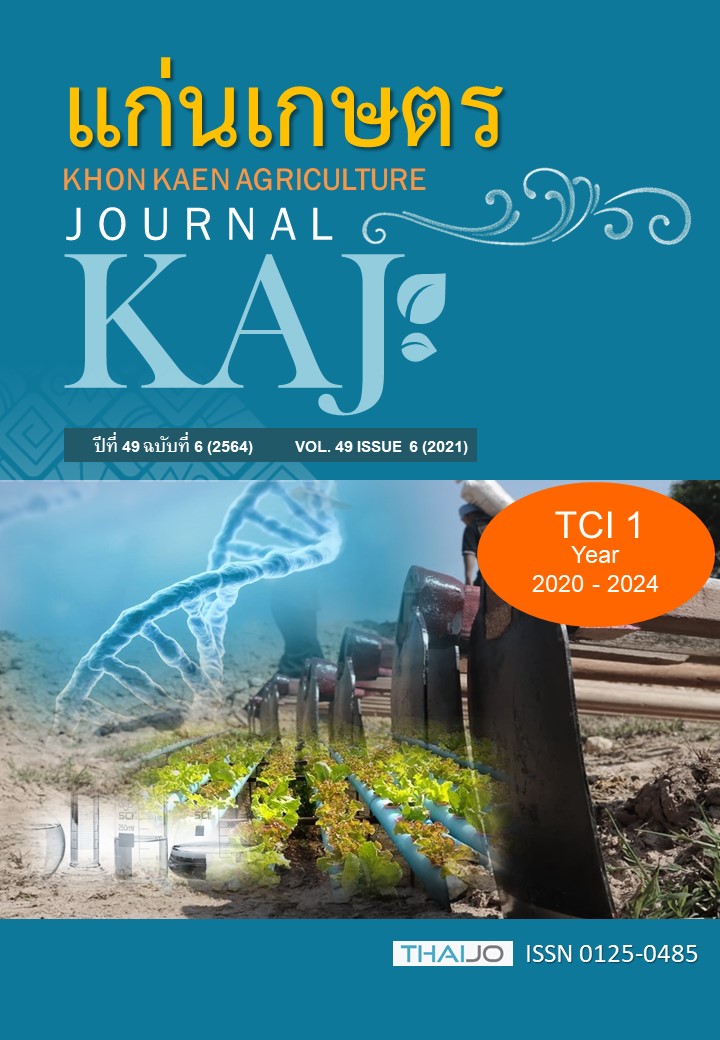การทดสอบประสิทธิภาพในการป้องกันโรคบิดที่เกิดจากเชื้อ Eimeria tenella ของผลิตภัณฑ์ Penergetic-t Broiler®และน้ำมันหอมระเหยอบเชยจีนในไก่เนื้อ
Main Article Content
บทคัดย่อ
การศึกษาประสิทธิภาพในการป้องกันโรคบิดจากเชื้อ E. tenella ของผลิตภัณฑ์ Penergetic-t Broiler® (PB) และผลิตภัณฑ์น้ำมันอบเชยจีน (COP)ทั้งในรูปเดี่ยวและการใช้ร่วมกัน โดยใช้ไก่เนื้อ (Ross308) เพศผู้ 96 ตัว ทำการเลี้ยงรวมกันบนพื้นปูด้วยแกลบและได้รับอาหารที่เสริมสารป้องกันโรคบิดจนอายุ 13 วัน จากนั้นแบ่งเป็น 8 กลุ่ม กลุ่มละ 6 ซ้ำ เลี้ยงในกรงตับละ 2 ตัว สุ่มไก่ให้ได้รับกลุ่มทดลองดังนี้ กลุ่ม 1 ไม่กรอกเชื้อและไม่เสริมสารป้องกันโรคบิด กลุ่ม 2-8 ได้รับเชื้อบิด 2,500 โอโอซิสต์ต่อตัว โดยไม่เสริมสารป้องกันโรคบิด (กลุ่ม 2), เสริมสารโรบีนิดีน 33 มก./กก.อาหาร (กลุ่ม 3), เสริมCOP ละลายน้ำดื่ม 0.20 มคล./มล. (กลุ่ม 4), เสริม PB ชนิดละลายน้ำดื่ม 500 มก./ล. (กลุ่ม 5), และร่วมกับ COP ที่ 0.20 มคล./มล. (กลุ่ม 6), เสริม PB ชนิดผสมอาหาร 2,000 มก./กก.(กลุ่ม 7), และร่วมกับ COP ที่ 0.20 มคล./มล. (กลุ่ม 8) ภายหลังการกรอกเชื้อบิด 7 และ 14 วัน ทำการสุ่มไก่ครั้งละ 1 ตัวต่อซ้ำเพื่อเก็บไส้ติ่งสำหรับประเมินคะแนนรอยโรคและเก็บมูลเพื่อนับจำนวนโอโอซีสต์ พบว่าหลังการกรอกเชื้อบิด 7 วัน ผลิตภัณฑ์ PB ชนิดผสมอาหาร 2,000 มก./ กก.ร่วมกับ COP ที่ 0.20 มคล./มล. แสดงประสิทธิภาพการป้องกันโรคบิดจากเชื้อ E. tenella ดีที่สุด ขณะที่ 14 วันหลังการกรอกเชื้อ ผลิตภัณฑ์ PB ชนิดละลายน้ำ 500 มก./ล. ร่วมกับ COP ที่ 0.20 มคล./มล. ช่วยฟื้นฟูเนื้อเยื่อไส้ติ่งดีที่สุด โดยสรุปผลิตภัณฑ์ PB ทั้งชนิดผสมอาหารและละลายน้ำ ร่วมกับ COP สามารถเป็นทางเลือกในการป้องกันโรคบิดในไก่เนื้อ
Article Details

อนุญาตภายใต้เงื่อนไข Creative Commons Attribution-NonCommercial-NoDerivatives 4.0 International License.
เอกสารอ้างอิง
กนกชล อินทร์วิมล, ทวีศักดิ์ ส่งเสริม, ภคอร อัครมธุรากุล, สุรพันธ์ จิตวิริยนนท์ และนวลจันทร์ พารักษา. 2562. การศึกษประสิทธิภาพการป้องกันโรคบิดที่เกิดจาก Eimeria tenella ของน้ำมันหอมระเหยอบเชยจีน. แก่นเกษตร. 47: 809-818.
ณัฐวุฒิ เจริญไทย และมัลลิกา ชมนาวัง. 2559. การพัฒนาน้ำมันอบเชยจีนชนิดระบบนำส่งยาแบบก่อให้เกิดไมโครอิมัลชันเองเพื่อใช้ในการต้านจุลชีพในไก่เนื้อ. รายงานวิจัยฉบับสมบูรณ์. สำนักงานกองทุนสนับสนุนการวิจัย, กรุงเทพฯ.
ทรงพล รดิศพงศ์. 2555. การแปลงข้อมูลผลการวิจัยโดยวิธีทางสถิติ. วารสารกรมวิทยาศาสตร์บริการ. 189: 16-19.
วรรณวิภา วรรณศิริ, นันทวัน บุณยะประภัศร, ทวีศักดิ์ ส่งเสริม และนวลจันทร์ พารักษา. 2558. การใช้ผลิตภัณฑ์น้ำมันหอมระเหยชนิดละลายน้ำเพื่อการป้องกันโรคบิดในไก่เนื้อ. แก่นเกษตร. 43: 729-738.
สุรพันธ์ จิตวิริยนนท์. 2559. การทดสอบประสิทธิภาพของสารสกัดสมุนไพรในการป้องกันโรคบิดในไก่เนื้อ. วิทยานิพนธ์ปริญญาปรัชญาดุษฎีบัณฑิต มหาวิทยาลัยเกษตรศาสตร์, กรุงเทพฯ.
อาริยา แสงศรี, เสาวลักษณ์ จงประกิจพงส์ และอำไพ นุสสติ. 2557. การเตรียมชิ้นเนื้อเยื่อด้วยน้ำยาเคมีเพื่อการตรวจทางพยาธิวิทยาโดยปราศจากไซลีน. สถาบันพยาธิวิทยา, กรมการแพทย์, กระทรวงสาธารณสุข, กรุงเทพฯ.
Bogosavljevic-Boskovic, S., S. Mitrovic, R. Djokovic, V. Doskovic, and V. Djermanovic. 2010. Chemical composition of chicken meat produced in extensive indoor and free range rearing systems. African Journal of Biotechnology. 9: 9069-9075.
Chapman, H. D., J. R. Barta, D. Blake, A. Gruber, M. Jenkins, N. C. Smith, X. Suo, and F. M. Tomley. 2013. A selective review of advances in Coccidiosis research. Advances in Parasitology. 83: 93-171.
Cobaxin-Cárdenas, M. E. 2018. Natural compounds as an alternative to control farm diseases: Avian Coccidiosis, pp.135-149. In: R. E. Quiroz Castañeda. Farm Animals Diseases, Recent Omic Trends and New Strategies of Treatment. IntechOpen, London, UK.
Conway, D. P., and M. E. McKenzie. 2007. Poultry Coccidiosis: Diagnostic and Testing Procedures. 3rd Edition. Blackwell Publishing, Australia.
Del Cacho, E., M. Gallego, H. S. Lillehoj, J. Quílez, E. P. Lillehoj, A. Ramo, and C. Sánchez-Acedo. 2014. IL-17A regulates Eimeria tenella schizont maturation and migration in avian coccidiosis. Veterinary Research. 45: 1-9.
Del Giudice, E., A. Tedeschi, G. Vitiello, and V. Voeikov. 2013. Coherent structures in liquid water close to hydrophilic surfaces. Journal of Physics. 6: 1-5.
FAOSTAT. 2014. Livestock poultry production. Live Animals (Production). Available: http://faostat.fao.org/. Accessed Aug. 25, 2020.
Foletti, A., M. Ledda, E. D'. Emilia, S. Grimaldi, and A. Lisi. 2011. Differentiation of human LAN-5 neuroblastoma cells induced by extremely low frequency electronically transmitted retinoic acid. Journal of Alternative and Complementary Medicine. 17: 701-704.
Foletti, A., L. Mario, P. Sara, G. Settimio, and L. Antonella. 2014. Electromagnetic information delivery as a new tool in translational medicine. International Journal of Clinical and Experimental Medicine.7: 2550-2556.
Heredia-Rojas, J. A., A. C. Torres-Flores, A. O. Rodríguez-De, B. D. Mata-Cárdenas, L. E. Rodríguez-Flores, M. P. Barrón-González, A. C. Torres-Pantoja, and J. M. Alcocer-González. 2011. Entamoeba histolytica and Trichomonas vaginalis: Trophozoite growth inhibition by metronidazole electro-transferred water. Experimental Parasitology. 127: 80-83.
Hong, C. H., S. K. Hur, O. J. Oh, S. S. Kim, K. A. Nam, and S. K. Lee. 2002. Evaluation of natural products on inhibition of inducible cyclooxygenase (COX-2) and nitric oxide synthase (iNOS) in cultured mouse macrophage cells. Journal of Ethnopharmacology. 83: 153-159.
Hooge, D. M., K. R. Cummings, J. L. McNaughton, C. L. Quarles, and B. A. George. 1999. Dietary sodium bicarbonate, coccidial challenge, and ionophore coccidiostats in broiler chickens. Journal of Applied Poultry Research. 8: 89-99.
Kant, V., P. Singh, P. K. Verma, I. Bais, M. S. Parmar, A. Gopal, and V. Gupta. 2013. Anticoccidial drugs used in the poultry: An overview. Forensic Science International. 1: 261-265.
Kennett, R. L., S. Kantor, and A. Gallo. 1974. Efficacy studies with robenidine, a new type of anticoccidial, in the diet. Poultry Science Journal. 53: 978-986.
Lal, K., E. Bromley, R. Oakes, J. H. Prieto, S. J. Sanderson, D. Kurian, L. Hunt, J. R. Yates, J. M. Wastling, R. E. Sinden, and F.M. Tomley. 2009. Proteomic comparison of four Eimeria tenella life-cycle stages: Unsporulated oocyst, sporulated oocyst, sporozoite and second-generation merozoite. Proteomics. 9: 4566-4576.
Lillehoj, H. S., and J. M. Trout. 1996. Avian gut-associated lymphoid tissues and intestinal immune responses to Eimeria parasites. Clinical Microbiology Reviews. 9: 349-360.
Mehlhorn, H., H. Pooch, and W. Raether. 1983. The action of polyether ionophorous antibiotics (monensin, salinomycin, lasalocid) on developmental stages of Eimeria tenella (Coccidia, Sporozoa) in vivo and in vitro: Study by light and electron microscopy. Zeitschrift fuer Parasitenkunde. 69: 457-471.
Norman, R. L., J. Dunning-Davies, J. A. Heredia-Rojas, and A. Foletti. 2016. Quantum information medicine: Bit as it-The future direction of medical science: Antimicrobial and other potential non-toxic treatments. World Journal of Neuroscience. 6: 193-207.
Peek, H. W. 2010. Resistance to anticoccidial drugs: Alternative strategies to control coccidiosis in broilers. Utrecht University Repository. Utrecht University, Netherland.
Peek, H. W., and W. J. M. Landman. 2011. Coccidiosis in poultry: anticoccidial products, vaccines and other prevention strategies. Veterinary Quarterly. 31: 143-161.
Prabuseenivasan, S., M. Jayakumar, and S. Ignacimuthu. 2006. In vitro antibacterial activity of some plant essential oils. BMC Complement. Alternative and Complementary Medicine. 6: 1-8.
Remmal, A., S. Achahbar, L. Bouddine, N. Chami, and F. Chami. 2011. In vitro destruction of Eimeria oocysts by essential oils. Veterinary Parasitology. 182: 121-126.
Shirley, M. W., A. L. Smith, and F. M. Tomley. 2005. The biology of avian Eimeria spp. with an emphasis on their control by vaccination. Journal of Parasitology. 60: 285-330.
Shridhar, N. B. 2007. Efficacy of penergetic-t on health and production status of cross-bred cows. Indian Journal of Animal Research. 41: 235-243.
Wong, D. T., J. S. Horng, and J. R. Wilkinson. 1972. Robenzidene, an inhibitor of oxidative phosphorylation. Biochemical and Biophysical Research Communications. 46: 621-627.
You, M. J. 2014. The comparative analysis of infection pattern and oocyst output in Eimeria tenella, E. maxima and E. acervulina in young broiler chicken. Veterinary World. 7: 542-547.


